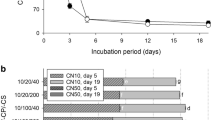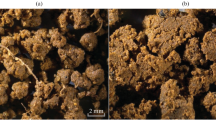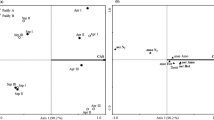Abstract
Growth rates of natural bacterial communities from Antarctic soils are analysed by an epifiuorescence microscopic method using data of microcolonies (colony number and colony areas). Incubations are performed on polycarbonate filters which are put on cellulose pads soaked with soil extracts, different concentrations of naturally occuring carbohydrates, polyols, and leucine. Concentrations of individual substrates were in the range of naturally occuring levels. The results showed that the growth of bacterial microcolonies could best be stimulated with glucose, sucrose, maltose, sorbitol, and mannitol. Leucine stimulated growth to a lower extent than glucose. Data on bacterial biomass production calculated from this approach are discussed in relation to those from tracer techniques carried out with 14C-labelled glucose from earlier experiments.
Similar content being viewed by others
References
Alef K (1991) Methodenhandbuch Bodenmikrobiologie. Ecomed Verlagsges., Landsberg
Anderson JPE, Domsch KH (1975) Measurement of bacterial and fungal contributions to respiration of selected agricultural and forest soils. Can J Microbiol 21:314–322
Babenzien H-D (1989) Bacteriological parameters and biomonitoring of waters: A comparison of sites. Limnologica 19:131–145
Bailey AD, Wynn-Williams DD (1982) Soil microbial studies at Signy Island, South Orkney Islands. Brit Antarct Surv Bull 51:167–191
Bölter M (1981) DOC-turnover and microbial biomass production. Kieler Meeresforsch Sdh 5:304–310
Bölter M (1989) Microbial activity in soils from Antarctica (Casey Station, Wilkes Land). Proc NIPR Symp Polar Biology 2:146–153
Bölter M (1990) Microbial ecology of soils from Wilkes Land, Antarctica. I. The bacterial population and its activity in relation to dissolved organic matter. Proc NIPR Symp Polar Biol 3:104–119
Bölter M (1992) Environmental conditions and microbiological properties from soils and lichens from Antarctica (Casey Station, Wilkes Land). Polar Biol 11:591–599
Bölter M, Liebezeit G, Wolter K, Palmgren U (1982) Submodels of a brackish water environment. III. Microbial biomass production and related carbon flux. PSZNI Mar Ecol 3:243–253
Bölter M, Dawson R, Liebezeit G, Wolter K (1987) Pelagic microbial production. In Seawater-sediment interactions in coastal waters. In: Rumohr J, Walger E, Zeitzschel B (eds). Springer Berlin, pp 57–68
Dudley SA, Lechowicz MJ (1987) Losses of polyol through leaching in subarctic lichens. Plant Physiol 83:813–815
Greenfield LG (1989) Water soluble substances in terrestrial Antarctic plants and microbes. NZ Nat Sci 16:21–30
Kerry E (1990) Effects of temperature on growth rates of fungi from Subantarctic Macquarie Island and Casey, Antarctica. Polar Biol 10:293–299
Kirchman D (1983) The production of bacteria attached to particles suspended in a freshwater pond. Limnol Oceanogr 28:858–872
Kogure K, Simidu U, Taga N (1979) A tentative direct microscopic method for counting living marine bacteria. Can J Microbiol 25:415–420
Kunicka-Goldfinger W (1981) Growth rate, and biomass production. In: Maciejowska M, Becker-Birck J, Hoppe H-G, Schneider J (eds) Recommendations on methods for marine microbiological studies in the Baltic Sea. Res Inst Environ Develop, Warsaw, pp 16–23
Kuparinen J (1984) Glucose assimilation: Its contribution to carbon flux in the pelagial and use in monitoring heterotrophic activity. In: Overbeck J, Hoefle MG, Krambeck C, Witzel K-P (eds) Proceedings of the second workshop on measurement of microbial activity in the carbon cycle of aquatic ecosystems. Ergebn Limnol 13:15–22
Melick DR, Seppelt RD (1992) Loss of soluble carbohydrates and changes in freezing points of Antarctic bryophytes after leeching and repeated freeze-thaw cycles. Antarct Sci 4:399–404
Meyer-Reil L-A (1975) An improved method for the semi-continuous culture of bacterial populations on Nucleopore membrane filters. Kieler Meeresforsch 31:1–6
Meyer-Reil L-A (1977) Bacterial growth rates and biomass production. In:Rheinheimer G (ed) Microbial ecology of a brackish water environment. Springer, Berlin, pp 221–236
O'Carroll K (1988) Assessment of bacterial activity. In: Austin B (ed) Methods in aquatic bacteriology, Wiley & Sons, New York, pp 347–366
Ramsay AJ (1983) Bacterial biomass in ornithogenic soils of Antarctica. Polar Biol 1:221–225
Ramsay AJ, Stannard RE (1986) Numbers and viability of bacteria from ornithogenic soils of Antarctica. Polar Biol 5:195–198
Riemann B, Bell RT (1990) Advances in estimating bacterial biomass and growth in aquatic systems. Arch Hydrobiol 118:385–402
Riemann B, Sørensen HM, Bjørnsen PK, Jesper SH, Jensen LM, Nielsen TG, Søndergaard M (1990a) Carbon budgets of the microbial food web in estuarine enclosures. Mar Ecol Progr Ser 65:159–170
Riemann B, Bell RT, Jørgenson NOG (1990b) Incorporation of thymidine, adenine and leucine into natural bacterial assemblages. Mar Ecol Progr Ser 65:87–94
Roser DJ, Melick DR, Seppelt RD (1992) Loss of polyhydric alcohols and sugars from lichens as an indicator of environmental pollution at a continental Antarctic locality. Antarct Sci 4:185–189
Roser DJ, Seppelt RD, Ashbolt N (1993a) The microbiology of ornithogenic soils from the Windmill Islands, Budd Coast, Continental Antarctica. II. Some observations on methods for measuring soil biomass. Soil Biol Biochem 25:165–175
Roser DJ, Melick DR, Ling HU, Seppelt RD (1993b) Polyol and sugar content of terrestrial plants from continental Antarctica as determined by gas-liquid chromatography. Antarct Sci 4:413–420
Sieburth JMcN, Brooks RD, Gessner RV, Thomas CD, Tootle JL (1974) Microbial colonization of marine plant surfaces as observed by scanning electron microscopy. In: Colwell RR, Morita RY (eds) Effect of the ocean environment on microbial activities. University Park Press, Baltimore, pp 418–432
Sparling GP, Ord BG, Vaughan D (1981) Microbial biomass and activity in soils amended with glucose. Soil Biol Biochem 13:99–104
Stamatiadis S, Doran JW, Ingham ER (1990) Use of staining and inhibitors to separate fungal and bacterial activity in soil. Soil Biol Biochem 22:81–88
Straskrabova V (1972) Microcolony method. In:Sorokin YI, Kadota H (eds) Microbial production and decomposition in fresh waters. IBP Handbook 23, Blackwell Sci. Publ., Oxford, pp 77–78
Tearle PV (1987) Cryptogamic carbohydrate release and microbial response during spring freeze-thaw cycles in Antarctic fellfield fines. Soil Biol Biochem 19: 381–390
Van Veen JA, Kuikman PJ (1990) Soil structural aspects of decomposition of organic matter by micro-organisms. Biogeochem 11:213–233
Zimmermann R (1977) Estimation of bacterial number and biomass by epifluorescence microscopy and scanning electron microscopy. In: Rheinheimer G (ed) Microbial ecology of a brackish water environment. Springer, Berlin, pp 103–120
Author information
Authors and Affiliations
Rights and permissions
About this article
Cite this article
Bölter, M. Effects of carbohydrates and leucine on growth of bacteria from Antarctic soils (Casey Station, Wilkes Land). Polar Biol 13, 297–306 (1993). https://doi.org/10.1007/BF00238356
Issue Date:
DOI: https://doi.org/10.1007/BF00238356




